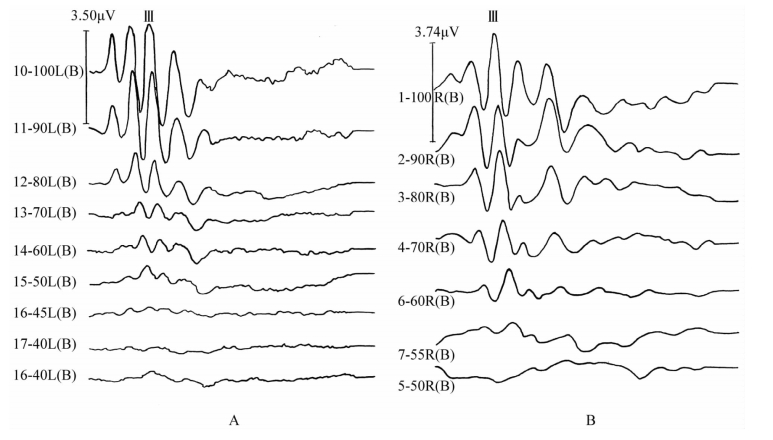六、动物实验
因豚鼠的听力学特征与人较接近,所以既往人们在做听觉生理实验时,多选用豚鼠。随着分子生物学的发展,因小鼠的基因与人类较接近,所以听觉生理较为宏观的研究逐渐更多的选用小鼠或大鼠了。然而不论豚鼠、小鼠或大鼠,其ABR均有自己的特点。大概是因为解剖学结构的原因,这些动物的ABR不像人一样在正常情况下常出现5个波,而是常常出现3个波,波Ⅳ、Ⅴ出现率低且不重复。因此判断其阈值时,通常以出现率最高的波Ⅲ作为判断阈值的指标(图5-19)。示豚鼠、小鼠的ABR波形及其波Ⅲ的阈值。

图5-19 ABR波形及阈值判断指标
A.左耳示豚鼠正常ABR波形及阈值(45dB SPL);B.右耳示小鼠正常ABR波形及阈值(55dB SPL)
电极放置:两耳郭前沿连线的中点为记录电极。通常用3号绣花针,轻轻钉透颅骨至硬脑膜外大约1mm深,以手指轻轻碰触针鼻处,动物头与针一体运动,即证明电极深度到位。参考电极置同侧耳垂,地线接鼻尖或对侧耳垂。平均器、放大器各参数的设置同引导人的ABR。刺激声可选短声、短音、过滤短声或平台较短的短纯音。引导动物的ABR简单易引,可监测动物造模前后听功能的变化,也可将动物放置固定盒内,保持清醒状态。在不同段的时间内,可重复安置记录电极3~5次,但必须避免电极植入过深伤及皮质而出现动物死亡。如果要做远期观察,可参考第4章引导CAP和第8章PR慢性电极植入法。
(李兴启 闻雨婷)
参考文献
1 Colletti V,Fiorino FG.Vulnerability of hearing function during acoustic neuroma surgery.Acta Otolaryngol,1994,114:264
2 Dort JC,Tobolski C,Brown D.Screening strate-gies for neonatal hearing loss:which test is best.J Otolaryngol,2000,29:206
3 Erenberg A,Lemons J,Sia C,et al.Newborn and infant hearing loss:detection and intervention.American academy of Pediatrics.Task force on newborn and infant hearing.Pediatries,1999,103:527
4 Fuse T.ABR finding in vertebrobasilar ischemia.Acta Otolaryngol,1991,111:485
5 Hashimoto I,Ishiyama Y,Yoshimoto T,et al.Brainstem auditory evoked potentials recorded directly from human brainstem and thalamus.Brain,1981,104:841
6 Liu GB.Functional development of the auditory brainstem in the tammar wallaby(Macropus eugenii):the superior olivary complex and its relationship with the auditory brainstem response(ABR).Hear Res,2003,175:152
7 Li Xingqi.Brain-stem and cortical Responses evoked by Eelectrical stimulation of the cochlea in guinea pigs.Chinese Joural of Physiological Sciences,1990,6(1):61
8 Murofushi T,Lwasaki S,Takai Y,et al.Soundevoked neurogenic responses with short latency of vestibular origin.Clinical Neurophysiology,2005,116:401
9 Nong D,Ura M,Owa T,et al.An acoustically evoked short latency negative response in profound hearing loss patients.Acta Otolaryngol,2000,120:960
10 Randold HB,Haupt H,Scheibe F.Cochlear blood flow following temporary occlusion of the cerebellar arteries.Eru Arch Otorhinoaryngol,1990,247:226
11 Sekiya T,Shimamura N,Yagihashi A,et al.Axonal injury in auditory nerve observed in reversible latency changes of brainstem auditory evoked potentials(BAEP)during cerebellopontine angle manipulations in rats.Hear Res,2002,173:91
12 Sininger YS,Wesson BC,Folsom RC,et al.Identification of neonatal hearing impairment:auditory brainstem responses in the perinatal period.Ear Hear,2000,21:383
13 Ushio I,Kaga K,Sakata H,et al.Auditory brainstem response and temporal boone pathology findings in a brain-dead infant.Int J Pediatr Otorhimolaryngol,2001,58:249
14 Yoshida S,Orihara H,Tanino T.Neonatal auditory screening with automated ABR.Nippon Jibiinkoka Gakkai Kaiho,2002,105:804
15 李兴启,于黎明,姜泗长.脑干反应的测试方法及正常值.军医进修学院学报,1982,3:30
16 李兴启,于黎明,姜泗长.耳蜗性感音神经性聋脑干反应的观察和分析.中华耳鼻咽喉科杂志,1985,(2):65
17 李兴启,于黎明,姜泗长.脑干病变时听性脑干反应变化的分析.中华医学杂志,1985,65:56
18 李兴启,罗惟民,张 萍,等.脑干及其他中枢病变时脑干诱发电位和耳蜗电图的表现.中华医学杂志,1986,66:46
19 李兴启,叶胜难.101例桥小脑角占位病变的听力学表现.耳鼻咽喉科头颈外科杂志,1997,3:1
20 李志华,蒋泽栋,陈 超,有缺氧病史早产儿在不同刺激速率下脑干听觉诱发电位的变化及意义.中国实用儿科杂志,2006,21(1):26
21 倪道凤,李奉荣,彭培宏.异常听性脑干反应分析.中华耳鼻咽喉科杂志,1996,31(1):36
22 裴 智,黄治物,陶泽璋,等.短音诱发听性脑干反应的特性观察.听力学及言语疾病杂志,2003(2):104
23 钱宇虹,梁 力,江 刚.正常青年人气骨导听性脑干反应的比较研究.听力学及言语疾病杂志,2002,10(2):76
24 宋江顺,钟乃川.高刺激率ABR测试对椎基底动脉短暂缺血发作性眩晕的研究.临床耳鼻咽喉科杂志,1994,8(5):265
25 王士礼,陈学明,叶燕芬.3种不同条件短纯音诱发听性脑干反应频率特异性观察.临床耳鼻咽喉科杂志,2002,16(7):330
26 吴敬杰,闫红涛,莫芳萍,等.大鼠颅脑损伤后不同频率刺激下脑干诱发电位的改变.四川大学学报(医学版),2006:37(1):73
27 殷善开,武文明,顾 瑞,等.听性脑干反应骨导刺激声的声学特性.听力学及言语疾病杂志,1999,7(1):13
28 于黎明,邵殿华,李兴启.听诱发电位的时变滤波.中华耳科学,2003,1(2):76
29 钟乃川,金 晶,段家德.高刺激率听性脑干反应诊断椎基底动脉短暂缺血性眩晕.临床耳鼻咽喉科杂志,1992,6(2):66
30 周 娜,于黎明,刘传莲,等.重度聋的声诱发短潜伏期负反应.听力学及言语疾病杂志,2003,15(3):169
31 赵建东,武文明,郗 昕.多频稳态诱发电位和听性脑干反应对感音神经性聋儿童客观听阈的评估.中国耳鼻咽喉颅底外科杂志,2005,11(2):95
